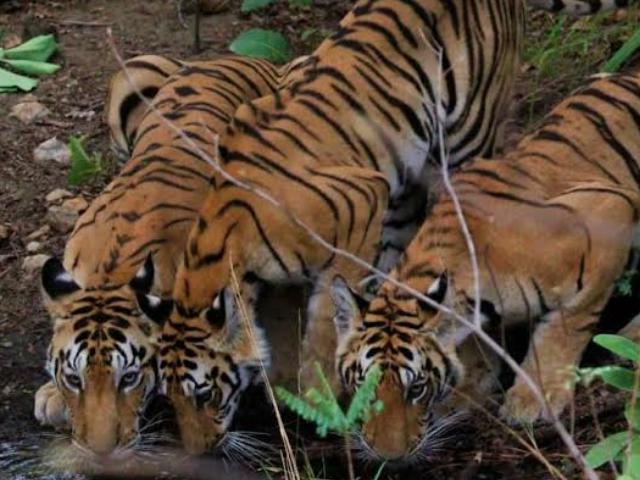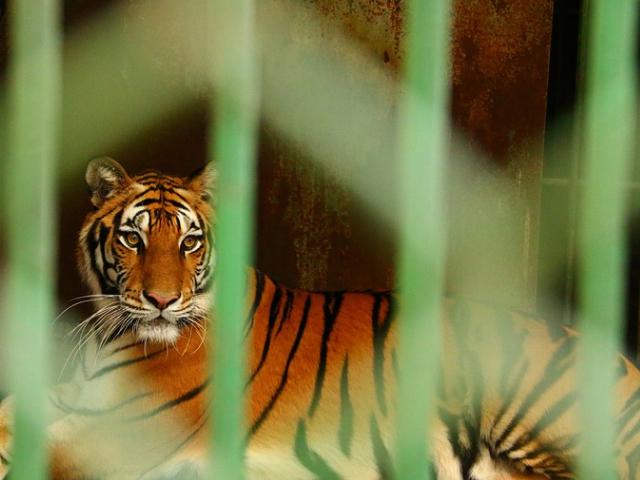India is facing a serious 'problem of plenty'. Rising tiger population in many parts of the country is creating conflict zones. And the tiger- human clashes are going up, alarmingly in many landscapes. The Union ministry of environment, forest and climate change (MoEFCC) needs to take initiatives to control the situation. Fifty years after the project tiger as India moves on from dwindling tiger population to surplus numbers of the big cats, the nation needs an active tiger population management plan. As MoEFC&C yet to become proactive, a team of tiger catchers continue to carry out search operations for the past over five months to capture a tigress with four cubs. The team members are scanning Tadoba Andhari Tiger Landscape in Vidarbha region of Maharashtra, grappling with the issue of over population of 250 tigers. As many as 53 people lost their lives in Chandrapur in 2022 in tiger attacks while 14 tigers have also died from January 2022 to January this year. This conflict zone is part of the Central India tiger landscape. Besides, the Terai arc region in the north and southern states including Karnataka have also been facing a serious tiger-human conflict.
"Catch The Tiger or Face Suspension"
Also read: Shooting In Valmiki Tiger Reserve: Why More Tigers are Turning Into "Pests"
At the same time there were reports of death of two more people leading to the anger of the villagers. PCCF (wildlife) Maheep Gupta reissued orders to capture the remaining three cubs along with the tigress. Gupta said time is running out and “we have no option but to capture the cubs and the tigress”. “People of Gadchiroli and Wadsa have threatened to launch a stir and the law and order situation may go out of hand. “Though we don’t have space to keep them, something will be worked out,” he told the media in Nagpur. When the chief wildlife warden of Maharashtra said that he had no space to keep another tiger in a cage, he meant it. There are 18 wild tigers in cages in Gorewada rescue centre of Nagpur, majority of them are trapped from the forest area around Tadoba Andhari Tiger Reserve (TATR). Now the department is planning to expand the facility by spending a few crores.
Also read: Rising Tiger Numbers Midst Shrinking Forest Cover Makes No Sense
Sprawling across 19 districts in the states of Madhya Pradesh, Maharashtra and Chhattisgarh covering a total area of 1,43,551 square km, Central India tiger landscape supports a large number of tiger populations. Of the 1,43,551 square km, roughly 40,837km2 is under forest cover and has some of the country’s most famous tiger reserves and Protected Areas. This landscape, with some of the largest contiguous forested tracks connected through wildlife corridors. Some of the tiger reserves critical from a conservation standpoint in this landscape are Kanha, Satpuda, Pench, Melghat, Tadoba and Achanakmar. There are over 878 tigers (526 of MP and 352 of Maharashtra according to 2018 census) in these jungles.Of them an estimated 120 tigers are found outside Tadoba in Brahmapuri forest division and its fragmented forest area between Chandrapur and Gadchiroli districts, the most volatile region for tiger human conflict. “People here just hate tigers and the state forest department minister belongs to this region. He is worried about his elections”, said an official. When tiger kills a villager, people in many neighbouring also go against the animal . " This is detrimental to tiger conservation in long term", experts said.The minister had already announced that more tigers would be caught and caged. In fact, the forest minister Sudhir Mungantiwar has issued warning to forest department officials to capture the problem tigers or face the suspension .But is it the solution?
Need Active Tiger population Management Plan
The tiger population has doubled in the last 10 years. At the same time, forests have also seen a lot of destruction. The impact of deforestation of Indian forest over the last 100 years is now showing in the 21st century. In order to save their livelihood, both animals and people have started to fight with each other for their survival. Checking deforestation and finding a way to increase the forest landscape can be a way to reach a solution. Thirty five percent of India’s tiger ranges are outside protected areas and human-animal conflict affects over 75 per cent of the world’s wild cat species, according to a WWF-UNEP report. The report “A Future for All – A Necessity for Human-Wildlife Coexistence”, made public in July 2021, examined rising human-wildlife battles. With most of these protected areas disconnected from one another, many species rely upon human-dominated areas for their survival and shared landscapes. According to a report of Wildlife Trust of India (WTI), around 180 cases of conflicts between humans and big cats (tigers, leopards) leading to human deaths and injuries were recorded from 2000 to 2018 in and around Dudhwa-Pilibhit Tiger landscape of Terai Arc region. Of these, 98 pertained to tigers. Many of them were accidental cases when villagers visited the jungle to collect fuel wood or go out for open defecation. Tiger numbers are going up in Western ghats when the jungles continue to shrink.
Also read: Tigress Gets ‘Life Imprisonment’
Out of 53 tiger reserves in India, 20 are doing well but the remaining 33 have a deficit tiger population, a senior MoEFC& C official revealed. There are many tiger reserves with either no sign or hardly any sign of the presence of the big cat. They include Satkosia in Odisha and Buxa in West Bengal among others. Palamu tiger reserve in Jharkhand and Indrawati in Chattisgarh are still out of bounds because of Naxal problems in the region. To cut the long story short, experts say, “We need to sit down and chalk out a tiger introduction plan from the surplus area to these 33 tiger reserves.” They said, “ But before doing this, we need to know why they continue to be tiger deficient despite all efforts”. Tiger introduction plan without such understanding failed in Satkosia when people killed a tiger brought from Madhya Pradesh. Another tigress accompanying this male had to be captured and caged. She is languishing in Bhopal’s Van Vihar national park which is actually an open zoo and rescue centre.
Problem of Plenty Remains Unaddressed
Few years ago, eminent conservationist Ullas Karanth and then NTCA ( National Tiger Conservation Authority) member secretary Dr Rajesh Gopal analysed the tiger human conflict .In their report , Human – Tiger conflict: Cause, Consequence and Mitigation , they said, “ The present distribution of tigers in India consists of some isolated meta-populations, embedded within larger landscapes that are made up of protected reserves, multiple-use forests, and agricultural and urban areas. The protected reserves are essentially ‘sources’ for dispersing tigers that may survive for brief periods in the surrounding areas, before perishing from poaching or prey depletion. Conflict with humans is largely restricted to the edges of protected reserves, and some multiple-use forests or plantations”.
Also read: Coal Mining All Set To Threaten Tiger Corridors Around Tadoba
Karanth had taken into consideration the possibilities of tigers ``perishing from poaching or prey depletion“but the way they are being caught in Vidarbha region was, perhaps, beyond his imagination. He further said, “The extent of area of the conflict is, thus, relatively small which makes this a localized management problem. However, by its very nature, the conflict poses a serious dilemma for conservationists trying to promote human–tiger coexistence.” Wildlife managers are severely handicapped by stringent legal requirements, lack of financial resources and technical skills, as well as by social pressures generated locally in conflict situations, they opined. A clear policy framework would enable them to avoid ad hoc responses and deal with conflict situations much more logically and effectively. Such a policy framework should: Prioritize the need to keep tigers separate from incompatible human land uses at the scale of protected reserves. It should also aim to mitigate conflicts by prioritizing human needs on a larger landscape. This analysis may be politically correct but it has failed to hit the bull’s eye and the problem of plenty remains unaddressed.
By Deshdeep Saxena
Representational Images, Tiger in cage from Pixabay.com





Comments
Post a Comment